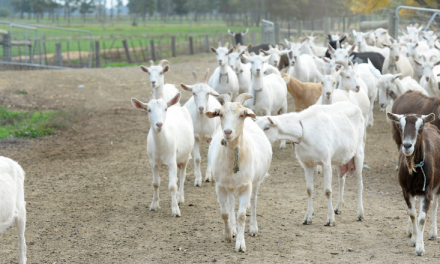Australia’s grain ‘balance sheet’ is set to materially tighten over the next decade, with increasing demand for grain to feed livestock – coupled with growing human consumption – well outstripping projected supply, according to a recently-released industry report.
This will see the proportion of the nation’s grain harvest exported annually decline from the current 60 per cent to 53 per cent by 2030, and may also increase the likelihood of further grain imports into the country over time.
In its report The Australian Feed Grain Squeeze, agribusiness banking specialist Rabobank says by 2030, the domestic market for cereal grains (wheat, barley, oats and sorghum) will soak up an additional six per cent of Australia’s annual production, leaving available supply for exports down by two million tonnes (or 10 per cent under the current five-year average).
Report author, Rabobank senior grains analyst Cheryl Kalisch Gordon (pictured) said the bank is forecasting domestic demand for cereal grains to grow by 2.3 per cent per annum over the next 10 years (to above 17.5 million tonnes a year by 2029/30), well exceeding projected annual supply growth of only 0.4 per cent per annum over the same period.
More mouths to feed
Livestock feed will take an increasing proportion of Australia’s domestic grain supply, the report says, driven by a rise in the number of stock being fed grain to satisfy local and international demand for animal protein.
Increased human consumption of food products containing grain will also fuel part of the rising demand.
“Despite changing diets, which have seen people’s consumption of wheat and other coarse grains fall on a per capital basis, Australians will still consume more grain due to population growth,” Dr Kalisch Gordon said.
“Overall, this will see an increase in demand for cereal grains in Australia, due to both direct consumption of grain in products – such as breakfast cereals, bread, cake, biscuits, pasta and beer – and also derived demand for grains to feed livestock that supply animal protein products, including beef, lamb, chicken, pork, eggs, milk and fish.”
This domestic appetite will also be augmented by a strongly-growing demand for Australian beef and lamb in export markets for at least the next five years, she said, as “the global protein market resets as a consequence of the African swine fever epidemic in China”.
Dr Kalisch Gordon said a higher level of growth in feed-grain demand – compared with human consumption – forecast over the next decade meant the share of cereal grains going to feed in Australia would approach 70 per cent by 2029/30, up from 64 per cent (the five-year average to 2018/19).
“As such, we will not only see increased demand for grains in Australia, but an increase in the relative importance of feed grain as an end use compared with milling, malting and processing for human consumption,” she said.
Supply
On the supply side, the report says, production growth will not be able to keep up with the forecast increase in demand over the coming decade.
“We expect Australian cereal grain supply to increase by just 0.4 per cent annually over the next 10 years,” Dr Kalisch Gordon said.
“In the absence of any new technologies that offer step change improvements in yield growth – and in the face of a drying climate and challenges to crop management, such as herbicide resistance and potential limits on the use of glyphosate – we do not expect future yield growth to exceed historical growth trends.”
Dr Kalisch Gordon said with a “southerly contraction” already occurring across Australia’s cropping belt due to climate challenges, as well as relative commodity pricing, the bank was not expecting cropping area growth in the forecast period.
“And while genetic modification and new plant-breeding techniques offer the potential for step change increases in yield that would offset the feed grain squeeze, we consider the likelihood of development, adoption and end-market acceptance low within the coming decade,” she said.
As such, the report says, Rabobank expects average Australian cereal grain production to be at around 37.5 million tonnes by 2030, up from the current five-year average of 35.8 million tonnes.
“However, Australian production will continue to be prone, and possibly more vulnerable, to year-to-year variation, so a range of 20 million to 52 million tonnes must be considered part of the outlook,” Dr Kalisch Gordon said.
Exports and imports
The report says the expected low rate of production growth, together with the forecast increase in domestic demand, will reduce Australia’s annual export surplus – from an average of 22 million tonnes of wheat, barley, oats and sorghum (2014/15 to 2018/19) to an export surplus closer to 20 million tonnes by 2030.
“This will result in the proportion of Australia’s grain production going to exports reducing from typically being 60 per cent of annual production to 53 per cent by the end of the next decade,” Dr Kalisch Gordon said.
And, while Australia would “remain a net exporter of cereal grains”, she said, there was increased potential to see further grain imports coming into the country over the next decade.
“Feed grains may be imported if the basis (price) reaches sufficiently high levels to cover freight and compliance with import biosecurity measures. However, the import of food-grade grains for milling, malting or other processing will be more likely.”
East/west divide and price
The Rabobank report says grain ‘balance sheet’ tightening will be particularly focussed on Australia’s eastern states “where supply growth will be lowest and demand growth highest”.
“The highest forecast growth in cereal supply will be in Western Australia and South Australia,” the report says. When it comes to demand though, growth will continue to be concentrated on the east coast of Australia.
“Together, Victoria, NSW and Queensland account for close to 80 per cent of Australia’s population and have the highest forecast population growth over the coming decade,” Dr Kalisch Gordon said. “They also have more than 90 per cent of the country’s feedlot capacity, more than 65 per cent of its milling capacity and more than 70 per cent of poultry sector capacity.”
This tightening is expected to see the average underlying east coast basis rise by as much as five per cent per annum, she said.
“For WA and South Australia, higher supply growth will put downward pressure on the basis between local grain prices and global prices, though prices are expected to be supported more often by demand for their grain from the eastern states.”
The growing demand for livestock feed will also narrow the premiums for food-grade grain and improve the profitability of growing feed grains in Australia, especially in Queensland, NSW and Victoria, the report says.








